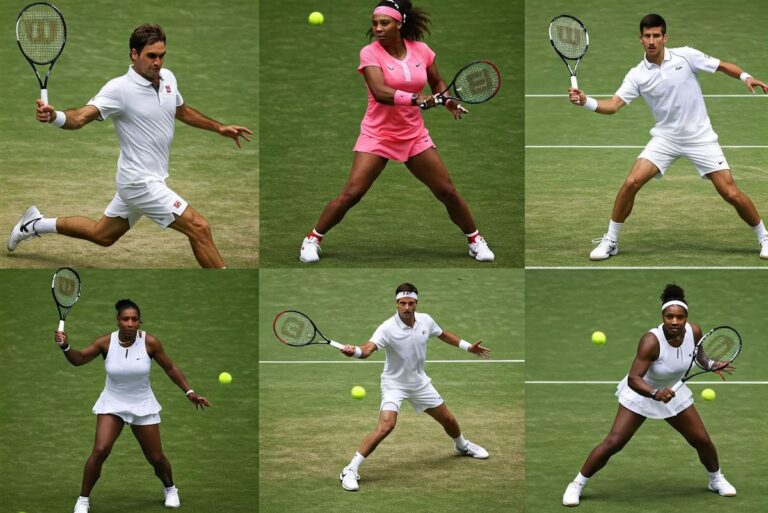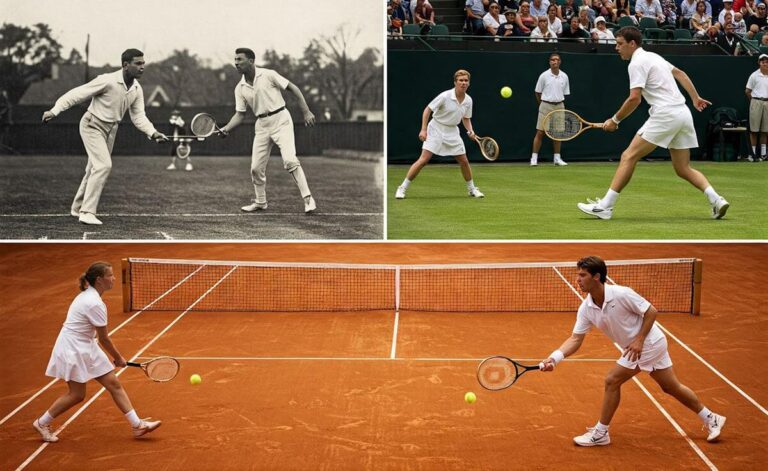Understanding Your Playing Style
Choosing the right tennis racket is crucial for enhancing performance, and a significant factor in making this selection is understanding your playing style. Tennis players generally fall into three main categories: baseline players, serve-and-volley players, and all-court players. Each of these styles requires a different type of racket to optimize game strategy and efficiency.
Baseline players typically engage in rallies from the back of the court, relying on groundstrokes to win points. For this playing style, rackets with larger head sizes and lighter frames are often preferred. These features provide a larger sweet spot and increased power, which can aid in generating depth and consistency from the baseline. A more forgiving racket can help baseline players develop their skills over time by allowing for effective shots even on mis-hits.
On the other hand, serve-and-volley players excel in aggressive play, often approaching the net to put pressure on opponents. This style demands rackets that offer good stability and maneuverability. A frame that is slightly heavier or has a thinner beam can enhance control, allowing for precise volleys and serves. Additionally, a smaller head size may provide better feedback on shots, which is beneficial for those aiming for strategic placement.
All-court players blend elements of both styles and require versatility in their racket choice. These players thrive on adaptability, often switching between baseline rallies and net play based on the match’s needs. Rackets designed for all-court players usually combine features from both baseline and serve-and-volley designs, striking a balance between power and control. A racket with adjustable string tension can also assist in personalizing performance based on specific playing conditions.
To identify your playing style, consider the types of shots you favor and the strategies you employ during matches. Observing your game can reveal whether you lean towards a specific style, which will guide you in selecting the optimal racket that complements your needs. Taking these insights into account is essential for enhancing your overall performance.
Factors to Consider in Racket Selection
Choosing the right tennis racket can significantly influence your performance on the court. Several critical factors merit consideration when selecting a racket, including head size, weight, balance, grip size, and string pattern. Each of these elements plays a distinct role in determining how well a racket suits your playing style and offers comfort during use.
The head size of the racket is an important aspect; it affects both power and control. Rackets are generally categorized as oversized, midplus, and midsize. An oversized racket provides a larger sweet spot, which can be beneficial for beginners by enhancing power and forgiveness on off-center hits. Conversely, experienced players may prefer a midsize head for better control and precision, enabling them to dictate the pace of their shots.
Weight is another factor to consider. Heavier rackets offer better stability and control, allowing for deeper shots and improved handling against fast serves. However, they require greater strength and technique to maneuver effectively. Lighter rackets facilitate faster swings and are often favored by players looking to enhance their agility. It is essential to find a balance that matches your physical capabilities and playing style.
Balance refers to the distribution of weight throughout the racket. Rackets can be head-heavy, head-light, or evenly balanced. A head-heavy racket tends to provide more power upon contact with the ball, suitable for those who need assistance with generating force. On the other hand, head-light rackets are more maneuverable, making them ideal for quick volleys and net play.
The grip size is crucial for comfort and control. A proper grip size ensures a secure hold and minimizes the risk of injury. Measuring requirements for grip size involves holding the racket and checking if there is a gap that allows a finger to fit comfortably between the fingertips and the palm. Lastly, the string pattern can influence spin and power; more open patterns offer increased spin potential, while denser patterns provide more control.
The Importance of Racket Weight and Balance
Choosing the right tennis racket is essential for enhancing performance on the court, and two critical factors in this decision are the racket’s weight and balance. The weight of a racket plays a pivotal role in swing speed and power generation. Generally, lighter rackets allow for quicker swings, enabling players to react faster and generate more spin. Conversely, heavier rackets can provide greater stability and power, though they might require more strength to maneuver effectively. Individuals should consider their physical conditioning and playing style when deciding on the appropriate weight for their racket.
When it comes to the balance of a racket, the distribution of weight affects control and maneuverability. Rackets can be categorized as head-heavy, head-light, or evenly balanced. Head-heavy rackets tend to provide more power, as the extra weight at the top enhances momentum during the swing. However, this can come at the cost of control and quick reflex movements. On the other hand, head-light rackets allow for better maneuverability, making it easier to perform quick volleys and changes in direction. This may be advantageous for players who rely on speed and quick adjustments during the game. A balanced racket offers a mix of both power and control, providing an all-around experience for various playing styles.
Finding the right combination of weight and balance ultimately depends on personal preference and playing style. Players should seek to demo various rackets before making a final decision. Testing different rackets can provide invaluable insights into how weight and balance influence overall performance. This process will help players align their equipment with their individual skills and preferences, ultimately leading to an enhanced gaming experience. Being mindful of these characteristics is vital for any player looking to elevate their game on the court.
Choosing the Right Grip Size
The grip size of a tennis racket significantly influences a player’s performance and comfort on the court. An appropriate grip size ensures not only optimal control over the racket but also minimizes the risk of injuries. A grip that is too large can lead to excessive tension in the hand, resulting in strain and potential long-term issues. Conversely, a grip that is too small may lead to lack of control and can cause blisters due to excessive movement.
To find the correct grip size, the first step is to measure the size of your hand. One of the most common methods involves using a ruler to measure from the tip of your ring finger to the base of your palm. This measurement in inches is generally correlated with grip sizes; for instance, a measurement of 4 inches often corresponds to a grip size of 4 1/8, while 4 1/4 inches matches with a grip size of 4 3/8.
Additionally, you can use the ‘index finger test.’ Hold the racket with the dominant hand and place the index finger of your opposite hand in the gap between your ring finger and palm. If your index finger fits comfortably, the grip is likely the right size. If it feels cramped or too loose, you may want to consider adjusting the grip size accordingly.
It is also advisable to try out a few rackets with varying grip sizes before making a final decision. This allows you to assess how the racket feels during swings and while making contact with the ball. Often, comfort is a crucial indicator of the right size, as you should feel confident and at ease when executing your shots. By ensuring a proper fit, you can enhance your game, improve your control, and ultimately enjoy a more pleasurable tennis experience.
Exploring Head Sizes and Their Effects
Choosing the right head size for a tennis racket significantly influences a player’s performance on the court. Generally, tennis rackets are categorized into three primary head sizes: oversize, midplus, and midsize. Each size has its unique characteristics that cater to different playing styles and skill levels.
Oversize rackets typically have a head size of 105 square inches or larger. They provide a larger sweet spot, which can be particularly advantageous for beginners or players who experience difficulty consistently hitting the ball. The expanded surface area enhances power and forgiveness, allowing for more errors without compromising the outcome of the shot. However, the larger head size may also make it challenging for advanced players who prefer precision and control, potentially sacrificing accuracy in exchange for power.
Midplus rackets, ranging from 98 to 104 square inches, offer a balanced compromise between power and control. This head size is ideal for intermediate players who have developed sufficient skills and are looking to refine their game. The midplus design provides a moderate sweet spot that allows for solid performance in both power and shot placement. Players can enjoy the benefits of a forgiving racket without the downsides of an oversize racket, capturing the essence of control while still harnessing considerable power.
Lastly, midsize rackets, which fall below 98 square inches, are favored by advanced players and professionals. This size requires a higher skill level since it demands precision and technique in ball striking. Midsize rackets provide exceptional control and feel but often lack the power that some players might seek, making them less suitable for beginners. Ultimately, the choice of head size is crucial, as it forms the foundation upon which a player builds their game and develops their style.
Understanding Racket String Patterns
The string pattern of a tennis racket plays a crucial role in determining the characteristics of a player’s performance. Broadly, there are two types of racket string patterns: open and dense. Each type offers distinct advantages and disadvantages that can influence aspects such as spin, power, and control, making it essential for players to choose wisely according to their personal playing style and goals.
An open string pattern typically features fewer strings, allowing for greater spacing between them. This design facilitates increased ball contact with the strings, which can generate heightened spin. Players who prioritize a topspin-heavy game often favor open patterns for their ability to create and manipulate spin more effectively. However, one trade-off of open strings is that they generally yield less control and may produce a softer feel, potentially leading to less precision on significant shots.
Conversely, a dense string pattern has a more tightly woven alignment of strings, offering a more solid and controlled response upon ball impact. This configuration tends to enhance the player’s control over their shots, which is highly beneficial for tennis players who focus on placement and accuracy. However, one must consider that a dense pattern may limit the capacity to generate spin, restricting those who employ heavy topspin as part of their game.
Ultimately, the decision between open and dense string patterns should align with one’s individual objectives. Beginners may lean towards an open pattern to cultivate their spin abilities, while intermediate to advanced players may opt for a dense string setup to enhance their precision. Understanding the nuances of string patterns can significantly enhance a player’s overall experience and performance on the court. Careful consideration of each option’s pros and cons will empower players to make informed choices aligned with their desired playing style.
Trying Rackets: Demo Programs and In-Store Testing
When selecting a tennis racket, it’s imperative to thoroughly test various options before making a purchase. Many sporting goods stores and specialized tennis shops offer demo programs, allowing players to borrow rackets for a limited time. This opportunity is particularly valuable for assessing how different rackets cater to your unique playing style and physical attributes. Engaging in a demo program can reveal which components, such as weight, balance, and grip size, suit you best.
During the trial period, take the time to experiment with various strokes and techniques. Pay close attention to how the racket feels during serves, volleys, and groundstrokes. Additionally, evaluate how it handles impact; a racket that feels stable upon hitting the ball contributes to improved confidence during play. If possible, provide feedback on multiple rackets, noting how each option influences your performance and comfort level.
In-store testing can also be advantageous. Before committing to a purchase, visit a store that allows you to swing the racket in a practice area or on a demo wall. This hands-on experience enables you to assess the racket’s maneuverability and touch. Make sure to consider the racket’s head size, string tension, and overall frame stiffness, as these factors significantly influence gameplay.
Moreover, consulting with knowledgeable staff in these stores can enhance your selection process. They can offer insights into the latest technologies and advancements in racket design, helping you make a more informed decision tailored to your needs. Ultimately, taking advantage of demo programs and performing thorough in-store testing provides a comprehensive approach to finding the right tennis racket that aligns with your game.
Budgeting for Your Ideal Racket
When selecting the ideal tennis racket, understanding how to budget effectively is crucial for ensuring a balance between quality and affordability. The price range of tennis rackets can vary significantly, typically ranging from around $30 for beginner models to over $300 for high-end, professional-grade rackets. It is essential for players to establish a budget that aligns with their skill level and frequency of play.
Investing in a quality racket can greatly enhance your performance on the court. Higher-priced rackets often feature advanced materials and technology that can improve your power, control, and overall playing experience. For recreational players, it may be wise to select a mid-range racket that offers a good blend of durability and playability without breaking the bank. While spending within your means, one should not sacrifice essential features that contribute to proper technique and comfort.
For those on a tighter budget, exploring discount options or second-hand rackets can be a viable alternative. Many sporting goods stores offer sales at the end of the season, providing an opportunity to purchase last year’s models at reduced prices. Additionally, second-hand rackets can often be found in excellent condition through online marketplaces or local sports clubs. However, when considering these options, it is important to thoroughly inspect the racket for any signs of wear or damage that could affect performance.
Ultimately, budgeting for a tennis racket requires careful consideration of both financial and personal playing preferences. By investing a reasonable amount into a suitable racket, players can significantly enhance their game while ensuring they have equipment that supports their development on the court. A well-considered financial decision in this area can lead to lasting satisfaction and improved performance as an athlete.
Maintaining Your Racket for Optimal Performance
To ensure a prolonged lifespan and optimal performance of your tennis racket, it is crucial to adopt a consistent maintenance regimen. Proper care not only enhances playability but also significantly impacts the overall experience on the court. One of the first steps in racket maintenance is addressing the strings. Regular inspection of the strings is essential, as they are the primary interface between the player and the ball. Be vigilant for any frays or breaks, and consider restringing your racket every six to eight weeks, depending on your frequency of use and playing style. If you frequently engage in competitive play, the need for timely restringing becomes even more critical.
In addition to string maintenance, it is beneficial to conduct regular inspections of the racket frame for signs of damage. Look for cracks, dents, or any unusual deformation of the frame. Such issues can compromise the integrity and performance of your racket. If any damage is discovered, it is advisable to consult a professional for potential repairs, as using a damaged racket can lead to poor performance and may increase the risk of injury.
Storage practices also play a pivotal role in maintaining your tennis racket. Always store your racket in a protective cover to shield it from dust, dirt, and environmental factors. Keeping the racket in a temperature-controlled environment helps prevent warping, which can occur with exposure to heat or extreme cold. Avoid leaving your racket in a hot car or direct sunlight, as these conditions can adversely affect the materials and performance of the racket.
Ultimately, treating your tennis racket with care, through regular string maintenance, diligent inspections, and appropriate storage methods, is essential for ensuring that you achieve an optimal game experience. By prioritizing racket maintenance, you invest not only in your equipment’s longevity but also in your personal performance on the court.



